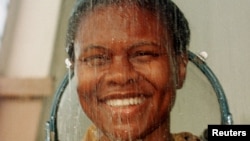An astronaut and an engineer with the U.S. space agency, NASA, have a message for women and minorities who want to get ahead: Look for opportunities in space research.
Women and minorities are underrepresented in aerospace engineering, so the two women urged students in Los Angeles to set their sights high when thinking about a career.
The thrill of weightlessness aboard the International Space Station and other exciting challenges await students with the right education, said Yvonne Cagle, a medical doctor and astronaut who recently talked about her training at Town Hall Los Angeles, a nonprofit speakers forum in Los Angeles. She urged students to reach for the stars.
Astronauts master tasks through discipline and training, she said, “which means we develop our basic skills and then we continue to do those things over and over again ... so we build in a kind of muscle memory.”
The students liked the message. “Science and math have always been my favorite subjects in school,” said high school student Vanessa Ramirez.
Her classmate, Tammy Busari, said Cagle inspired her because she was an astronaut and a fellow African-American.
Across town at the Los Angeles Central Library, a miniature mobile robot inspired by the Mars rovers was part of another demonstration about space. Mallory Lefland, an engineer with NASA’s Jet Propulsion Laboratory in Pasadena, California, helps control the real rovers by radio.
“We have some kids who love to actually build and engineer the robots," teacher Carolyn Polchow said, explaining the kids' fascination with the subject. "We have others who absolutely love to program the robots.”
A female student in her third year of robotics added, "I have a knack for it.”
These kids are typical. “People really like the idea of exploring space,” said engineer Lefland. “I think when you can show them, 'This picture was taken from Mars; I sent the command to take this photo,' I think you put a real human aspect on it. These are things you can do.”
Less than 20 percent of American engineers are women, and even fewer are in aerospace engineering. African-Americans and Latinos make up less than 10 percent of engineers.
But the numbers are growing. Cagle, part of NASA's outreach team, said the ship that carries astronauts to space is a symbol of her message — "the importance of dreaming” — because "that is really what your space vehicle is. The dream is within reach of all these students.”









